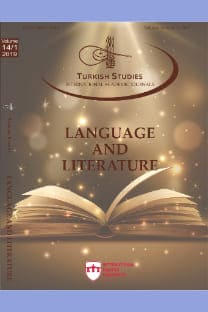Adaptation Study of The Inventory For Translation As a Learning Strategy
Öğrenme Stratejisi Olarak Çeviri Ölçeğini Türkçeye Uyarlama Çalışması
___
O’Malley, J.M. & A.U. Chamot. (1990) Learning strategies in second language acquisition. Cambridge University Press.Çokluk, Ö., Şekercioğlu, G., Büyüköztük, Ş. (2014), Sosyal bilimler için çok değişkenli istatistik SPSS ve LISREL uygulamalar., Pegem Akademi.
Deniz. Z. K. (2007) The adaptation of psychological scales, Journal of Faculty of Educational Sciences, vol: 40, no: 1, 1-16, Ankara University. https://www.researchgate.net/publication/284460462_The_Adaptation_of_Psychological_S cales sayfasından erişilmiştir.
Dural, S., Aslan, G., Alinçe, M. ve Araza, A. (2014). “Örgütsel çekicilik: bir ölçek uyarlama çalişmasi.” Doğuş Üniversitesi Dergisi, 15 (2), 141-154.
Hambleton, R. K., & Patsula, L. (1999). Increasing the validity of adapted tests: Myths to be avoided and guidelines for improving test adaptation practices. Journal of Applied Testing Technology, 1, 1-12.
Liao, P. (2002). Taiwanese college students’ Beliefs about translation and their use of translation as a strategy to learn English. Dissertation, The University of Texas.
Mollaei, F., Taghinezhad, A. & Sadighi, F. (2017). Teachers and learners’ perceptions of applying translation as a method, strategy or technique in an Iranian EFL setting. International Journal of Education & Literacy Studies. 5(2), 67-73. http://dx.doi.org/10.7575/aiac.ijels.v.5n.2p.67 sayfasından erişilmiştir.
Oxford, R. L. (1990). Language learning strategies: What every teacher should know. Newbury House.
Önder, İ. ve Beşoluk, Ş. (2010). “Düzenlenmiş iki faktörlü çalişma süreci ölçeği’nin (R-SPQ-2F) Türkçeye uyarlanmasi”. Eğitim ve Bilim, 35 (157), 55–67.
Sarıgül, H. (2015). Finansal okuryazarlik tutum ve davraniş ölçeği: geliştirme, geçerlik ve güvenirlik. Yönetim ve Ekonomi Araştırmaları Dergisi, 13(1), 200-218.
Stern, H. H. (1983). Fundamental concepts of language teaching, Oxford University.
Şencan, H. (2005). Sosyal ve davranışsal ölçmelerde güvenirlik ve geçerlik. Seçkin Yayınevi. https://www.ders.es/guvenilirlik_gecerlilik.pdf sayfasından erişilmiştir.
- ISSN: 2667-5641
- Yayın Aralığı: 4
- Başlangıç: 2006
- Yayıncı: ASOS Eğitim Bilişim Danışmanlık Otomasyon Yayıncılık Reklam Sanayi ve Ticaret LTD ŞTİ
Creativity in Literature and Drug Addiction
The False Friendship in Historical Texts - A Study of the Stories of Forty Viziers -
Kutadgu Bilig’de Akla Dair Etkili Bir Anlatım Yolu Olarak Somutlaştırma
Yeni Tarihselcilik Kuramı ve Louis De Bernieres’in Kanatsız Kuşlar Romanı Üzerine Bir İnceleme
"The Visit” in the Context of Morality – Justice - Money
Mete Tahsin KUŞGÖZ, Ceylan YILDIRIM
On the Side of Today's Historical Novels to Education
Murathan Mungan’s “Dokuz Anahtarlı Kırk Oda” in Terms of Intertextualty
Women Without Identity in the Story Evli Evinde* by Hulki Aktunç
